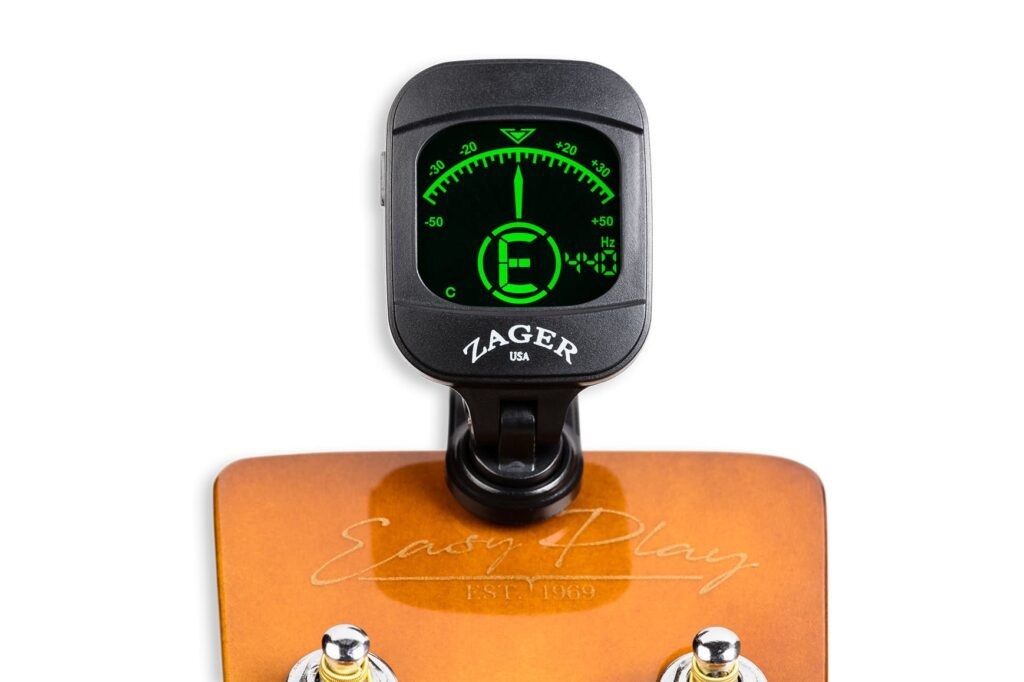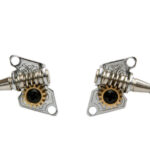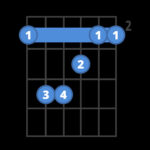Tuning a guitar is a fundamental skill for any guitarist, ensuring your instrument produces the harmonious sounds necessary for chords, scales, and the desired tone. While tuning a standard six-string guitar becomes second nature with practice, the twelve-string variant presents a unique challenge. With double the strings, achieving accurate tuning on a 12-string guitar requires a deeper understanding and a more meticulous approach.
The intricacies of Twelve String Guitar Tuning stem from several factors. The doubled strings necessitate precise intonation to avoid dissonance within each pair. The increased string count amplifies overall tension on the instrument, and frequency interference between closely pitched strings can further complicate the process. For those new to the instrument, or even seasoned six-string players, tuning a 12-string guitar can initially feel daunting.
However, the rich, chorus-like sound of a 12-string guitar is well worth the effort. Regular and accurate tuning is paramount, as even slight deviations in pitch on a single octave string can significantly alter the overall tonal character. This guide will provide a comprehensive walkthrough on how to tune your 12-string guitar effectively, ensuring you unlock its full sonic potential.
Unpacking the 12-String Guitar: Key Differences
Before diving into the tuning process, it’s crucial to understand the core differences between a standard six-string and a 12-string guitar. The most obvious distinction is the number of strings. A 12-string guitar features twelve strings arranged in six courses, or pairs. Each course consists of two strings, designed to be played together.
In most courses, one string is tuned to the same pitch as its partner, but an octave higher. These paired strings create the signature shimmering chorus effect that 12-string guitars are known for. Achieving this sound requires specific strumming techniques and a clean playing style to articulate all twelve strings effectively. The addition of these octave strings imbues the 12-string guitar with a richer, more resonant, and melodically complex voice compared to its six-string counterpart.
While the top two courses (E and B) are typically tuned in unison, the lower four courses (G, D, A, and E) are tuned in octaves. This pairing configuration contributes to the greater tension inherent in 12-string guitars. This increased tension is essential for maintaining proper pitch and resonance across all string pairs. However, it also translates to a higher string action and more pressure required to fret notes cleanly. This can be a significant adjustment for guitarists, particularly beginners, as holding down twelve strings simultaneously demands more finger strength and dexterity.
Furthermore, the amplified tension can place more stress on the guitar’s neck and body over time. This potential fragility can affect the instrument’s long-term tuning stability and overall performance. Players should be mindful of string gauge and consider professional setups to manage tension and ensure optimal playability.
Step-by-Step 12-String Guitar Tuning Process
The foundation of twelve string guitar tuning is standard tuning. Like a six-string guitar, the most common tuning for a 12-string is EADGBE. However, on a 12-string, the lower four courses (E, A, D, G) are doubled with strings tuned an octave higher. Some players opt to tune their 12-string guitar down a full step (DGCFAD) to reduce string tension, but standard E tuning remains the most prevalent.
When tuning, it’s best to work systematically from the lowest course (thickest strings) to the highest. For each course, you’ll be tuning a pair of strings to a single note within the EADGBE sequence. Within each pair, the thinner string is typically tuned an octave higher than the thicker string. When looking at your guitar, the higher octave string is usually positioned to the right of the lower-pitched string in each course.
Let’s break down the tuning process course by course:
- First Course (E): Begin with the thickest string pair, representing the low E. Tune the thicker string to E. Then, tune the thinner string in this pair to E as well, but one octave higher.
- Second Course (A): Move to the next pair. Tune the thicker string to A. Tune the thinner string in this pair to A, one octave higher.
- Third Course (D): Tune the thicker string of this pair to D. Tune the thinner string to D, one octave higher.
- Fourth Course (G): Tune the thicker string to G. Tune the thinner string to G, one octave higher.
- Fifth Course (B): Here, the tuning shifts slightly. Both strings in this pair are tuned to B in unison – meaning they are at the same pitch, not an octave apart.
- Sixth Course (E): Similar to the fifth course, both strings in this thinnest pair are tuned to E in unison.
By following these steps systematically, you will have tuned all twelve strings to the standard 12-string guitar tuning. While it might initially seem complex due to the doubled strings, with practice and familiarity with both standard and octave string relationships, the process becomes much smoother.
Essential Tuning Methods for 12-String Guitars
Knowing the correct tuning sequence is only half the battle. Accurately and efficiently tuning a 12-string guitar requires the right tools and techniques. Relying solely on ear training can be challenging, especially when discerning subtle pitch differences between octave strings. Fortunately, a range of guitar tuning accessories are available to simplify and enhance the process.
A reliable tuner is invaluable for achieving optimal sound from your 12-string. Let’s explore some of the most popular and effective tuning methods:
Chromatic Tuners: Precision Tuning at Your Fingertips
Chromatic tuners are highly versatile tools designed to detect and display the pitch of any musical note. This capability distinguishes them from standard guitar tuners, which are typically pre-set for specific guitar tunings. Chromatic tuners are adaptable to various instruments and alternate tunings, making them a staple for guitarists across genres.
 Zager High Accuracy Sonic Guitar Tuner
Zager High Accuracy Sonic Guitar Tuner
Chromatic tuners come in several forms, each offering unique advantages:
- Pedal Tuners: Popular among electric guitarists, pedal tuners are robust and designed for live performance. They often feature true bypass circuitry to maintain signal integrity and bright displays for visibility on stage.
- Clip-on Tuners: These compact tuners attach directly to the guitar’s headstock and detect vibrations to determine pitch. Clip-on tuners are convenient, accurate, and ideal for acoustic guitars as they are less susceptible to ambient noise.
- Microphone Tuners: These tuners rely on an internal microphone to detect sound. While they can be versatile, they may be less accurate in noisy environments compared to vibration-based tuners.
For twelve string guitar tuning, chromatic tuners are exceptionally useful. As you pluck a string, the tuner displays the detected pitch. You can then adjust the tuning peg until the tuner indicates the desired note is in tune. If the reading is “sharp” (pitch is too high), loosen the string. If it’s “flat” (pitch is too low), tighten the string. Chromatic tuners are readily available online and in music stores at various price points. Clip-on chromatic tuners are particularly well-suited for acoustic 12-string guitars due to their accuracy and ease of use.
Guitar Tuner Apps: Tuning Power in Your Pocket
In today’s digital age, smartphone apps have revolutionized many aspects of music-making, and guitar tuning is no exception. Guitar tuner apps leverage your smartphone’s microphone to measure and display the pitch of guitar strings. These apps offer a convenient alternative to standalone tuners, eliminating the need for extra equipment.
 smartphone, mobile phone, google games
smartphone, mobile phone, google games
Guitar tuner apps boast user-friendly interfaces and often provide a range of tuning options, including standard, alternate, and drop tunings. Many apps also incorporate helpful features like metronomes, chord libraries, and scale diagrams, making them valuable tools for practice and learning. The accuracy of a guitar tuner app largely depends on the quality of your device’s microphone. A phone with a good microphone can deliver surprisingly accurate tuning results.
Numerous guitar tuner apps are available for both Android and iOS devices through app stores and even web-based platforms. Many offer free versions with basic tuning functionality, while premium versions may unlock additional features or enhanced accuracy. Popular and highly-rated guitar tuner apps include GuitarTuna and Boss Tuner. Exploring these apps can provide a convenient and cost-effective solution for twelve string guitar tuning.
Zager 12-String Guitars: Crafted for Exceptional Sound and Playability
For players seeking a premium 12-string guitar experience, Zager Guitars offers exceptional instruments renowned for their playability and rich tone. The ZAD900CE 12 String Solid Spruce/Rosewood Acoustic Electric AURA Pro Series is a standout model, consistently ranked among the top guitars in the USA.
Constructed with solid Sitka Spruce and Indian Rosewood, this full-sized guitar boasts premium tonewoods and meticulous craftsmanship. Features like maple binding, abalone, and pearl inlays enhance its visual appeal, while gold Grover tuners ensure precise and stable tuning. As part of the Zager Pro Series, these guitars are designed for enhanced playability and a more powerful sound compared to their standard series instruments. The aged woods and thinner finish allow the soundboard to vibrate more freely, resulting in a deeper bass response and richer overall tone.
Experience the captivating sound of Zager 12-string guitars with a sound demo here. Explore the full range of Zager 12-string guitar models to discover the perfect instrument for your musical journey.
About Zager Guitars: Commitment to Beginner-Friendly Excellence
Zager Guitars prioritizes making guitar playing accessible and enjoyable, especially for beginners. They offer an exceptional accessory pack with every guitar purchase, providing essential tools to get started right away.
The Zager accessory pack includes:
- Free Zager pro-ABS digital humidified case ($199 value)
- Free lifetime membership to Mr. Zager’s Guitar Lesson Library ($295 value)
- Free year’s supply of Zager custom EZ-Play pillow touch strings ($89 value)
- Free year’s supply of Zager carbon guitar picks ($39 value)
- Free Zager leather padded strap ($48 value)
- Free Zager pro stainless capo ($39 value)
- Free expedited shipping ($79 value)
Zager guitars are engineered for easy playability through features like a custom bracing system and optimized string spacing. The bracing allows for slight soundboard flexibility, reducing the finger pressure needed for chording. Custom string spacing minimizes buzzing and rattles, contributing to a smoother and more comfortable playing experience.
FAQ: Addressing Common 12-String Tuning Questions
Is a 12-String Guitar Difficult to Tune?
Yes, tuning a 12-string guitar can initially be more complex than tuning a six-string due to the doubled strings and octave pairings. However, with practice, familiarity with the tuning process, and the use of quality guitar tuners, it becomes significantly easier. Consistent practice and patience are key to mastering twelve string guitar tuning. Alternative tunings on a 12-string can sometimes be challenging due to the increased tension, particularly with higher-pitched strings like the G string.
Is There an App For Tuning a 12-String Guitar?
Absolutely! Numerous apps and websites are specifically designed to simplify guitar tuning, including 12-string guitars. The free Guitar Tuners App (available for iPhone and Android) and GuitarTuna are excellent examples. GuitarTuna, in particular, offers a user-friendly interface and accurate tuning capabilities for 12-string guitars and various other instruments.
Are Chords the Same on a 12-String Guitar?
Yes, chord shapes and basic guitar skills are transferable from a 6-string to a 12-string guitar. You use the same chord forms and finger positions. However, playing a 12-string often involves strumming all twelve strings together, which can add complexity to advanced techniques. The richer harmonic texture created by the doubled strings enhances the overall chordal sound.
What is the Standard 12-String Guitar Tuning?
Standard E tuning (EADGBE) is the most common and widely used tuning for 12-string guitars. In this tuning, the E, A, D, and G string courses are tuned in octave pairs, while the B and high E courses are tuned in unison. This configuration creates the classic 12-string shimmer and resonance. The first six strings correspond to standard 6-string tuning, with the additional strings tuned in octaves to their counterparts, creating the characteristic 12-string sound.


